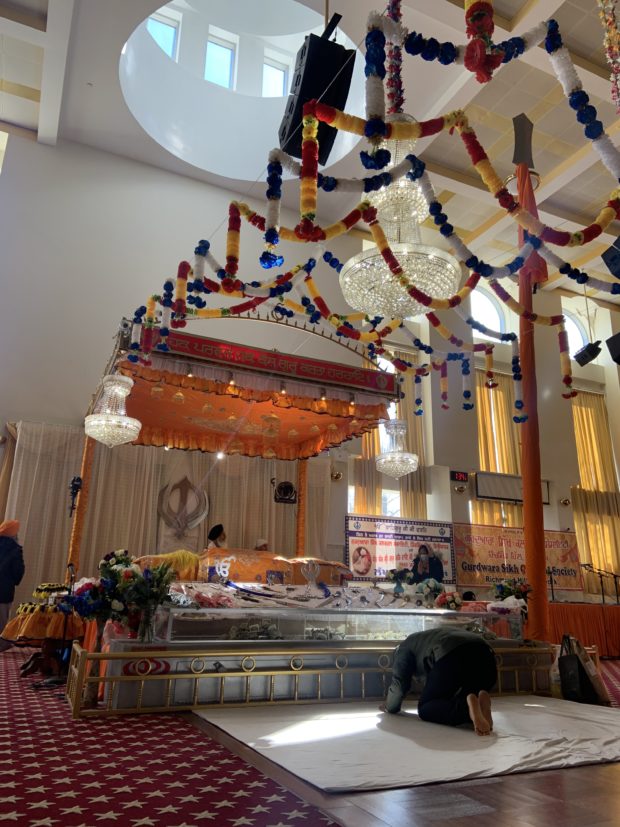On Sunday at The Sikh Cultural Society gurdwara at 118th Street in South Richmond Hill, Queens, a crowd of Sikh worshippers slip off their shoes and make their way to the Darbar Sahib for the day’s service. The women, many displaying their gold-adorned kurti tops, sit to the left of the hall. Men sit scattered on the burgundy carpet to the right of the room in rows. Their vibrant turbans in orange, turquoise, yellow and white dot half of the massive hall.
Though each worshiper performs daily readings on their own, they gather en masse at the gurdwara to learn from the Granthi’s interpretation of the Guru Granth Sahib. Granthis serve as guardians over the Sikh holy book, Guru Granth Sahib. Before the devoted hear the scripture, they see it. The seafoam green walls in the main hall display the day’s scripture in the Punjabi Gurmukhi script. Beside it is the English translation. This hukam, as it is called, is chosen at random and serves as the day’s guiding principle. Later on in the service, the gurus will recite and decipher the meaning.
There is a celebration of both life and death occurring on this Sunday. The usual crowd looms larger than previous ones. The seventh guru, Har Rai Sahib Ji, has a birthday. For Sikhs, this guru who died in the 17th century is revered for his military leadership. Across the hall from the hukam are images plastered in remembrance of Deep Sidhu, a famous Indian actor, lawyer and activist, who died the same week. Sidhu had been vocal in the recent Indian farmers’ protest about his support for the working class farmers against the Indian government. He is also a hero to those of Sikh faith.
The afternoon prayers begin with a memorial service to the late actor and activist. A man behind a podium makes a booming speech in Punjabi into a microphone. As he stands behind the podium addressing the room, he is being live-streamed online. He informs the youth in the room about Sidhu’s efforts, encouraging them to advocate for their beliefs like Sidhu. This message fell in line with a Sikh core tenet and practice, which is service to humanity and political activism.
The service transitions to singing from the youth. Six girls and two boys sing kirtan, songs of praise to God. Two girls in front played the harmoniums while off to the corner, one boy knocked the tabla drums to a beat. The song is chosen at random days before but prepared and sung according to the mood. Before harmoniums were introduced by the British to India, string instruments were played by the Sikh women for this practice. The harmoniums are easier to play but the string instruments require a skilled craft to turn out musical notes.
The worshipers sing along to the hymns but most make the descent to the basement’s kitchen for langar. When they return, the reading from Guru Granth Sahib is underway. In the prayer room, the elephantine book sits higher than everyone else. As a holy text, it must always be elevated. The Granthi sits behind it; his black turban peeping from the backdrop of a gold khanda, the Sikh symbol of swords. People stand with their hands clasped listening to the Granthi recite from the holy book in Punjabi. Once allowed to sit, they retreat to the carpet—legs crossed, listening intently.
 The Granthi is joined by a second Granthi who serves as the translator of the sacred text. In Punjabi, he explains what was just read from the scripture. All the while, the guardian of the holy text steadily waves a large canary yellow scepter, known as a chaur sahib, around the book. The chaur sahib is a ceremonial ornament that on one end is bejeweled and on the other, extended with animal hair that bears a strong resemblance to a horse’s tail.
The Granthi is joined by a second Granthi who serves as the translator of the sacred text. In Punjabi, he explains what was just read from the scripture. All the while, the guardian of the holy text steadily waves a large canary yellow scepter, known as a chaur sahib, around the book. The chaur sahib is a ceremonial ornament that on one end is bejeweled and on the other, extended with animal hair that bears a strong resemblance to a horse’s tail.
Faint whispers can be heard throughout the hall as people recite the scripture to themselves. Some younger Sikhs follow the words on apps on their phone. Then they all join in song. Some vocals pitch higher in the crowd and they sing out loud alone, as the music moves them.
Afterwards, people line up on the long wood panel corridor and prepare to bow and make optional donations in front of the shrine where the Granthi sat protecting the holy book. Once the initial bowing is over, some travel around the holy shrine area where they make additional bows and prayers around the square. A final prayer is said, internally or through a pale voice, at a pole dressed with the bright orange nishan sahib flag, where hands make a delicate touch before parting from the area.
When the service is over, the Guru Granth Sahib is draped with a vivid orange cloth beaded in Indian designs, known as the rumala, awaiting its removal to the upper floor of the gurdwara, where it will stay enclosed in a locked room until morning comes again.
